Special Feature: Building your dreams
We take a deep dive into the making of BYD’s innovative Blade Battery – the winner of Global New Energy Vehicle Innovation award.
Published On Oct 11, 2022 05:00:00 PM
14,240 Views
Follow us onDid you know that BYD is currently the world’s largest battery-powered carmaker? According to the Financial Times, BYD got hold of the mantle by retailing 6.41 lakh units over the second largest carmaker, which sold 5.64 lakh units in the same timeframe. How is BYD – short for Build Your Dreams – making a dent in the EV universe at such a staggering pace? Well, a high level of vertical integration has helped its cause, as BYD has in-house semiconductor, energy storage and battery manufacturing units. In fact, BYD now contributes to 10 percent of global battery production, already. Its current battery building capacity has doubled to 80 gigawatt-hours in just a period of three years and is expected to reach 185 gigawatt-hours by as early as 2025.
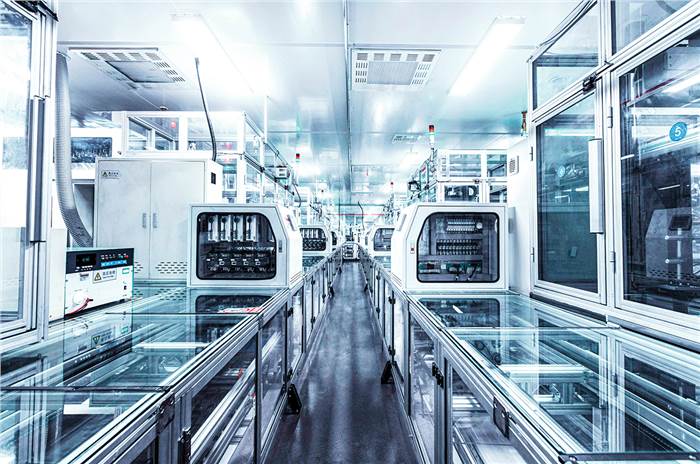 Since 1995, BYD has been into R&D, design and production, with applications in energy storage, power batteries, energy storage systems, consumer 3C batteries, etc.
Since 1995, BYD has been into R&D, design and production, with applications in energy storage, power batteries, energy storage systems, consumer 3C batteries, etc.
It’s not all about production though. A lot of credit goes to its R&D department, which spent around USD 1.477 billion in 2021 alone. BYD boasts of having a fully independent facility that incorporates R&D, design and production ability. With a rich, 27 years experience in building battery packs for not just cars, but also solar power stations, energy storage stations, rail transit and other renewable energy solutions, BYD is the global leader when it comes to Lithium Ion Phosphate (LFP) batteries. The result of which is the award winning Blade Battery that has been developed and produced by FinDreams Battery and will be powering future BYD models, including its soon-to-be-launched SUV in India.
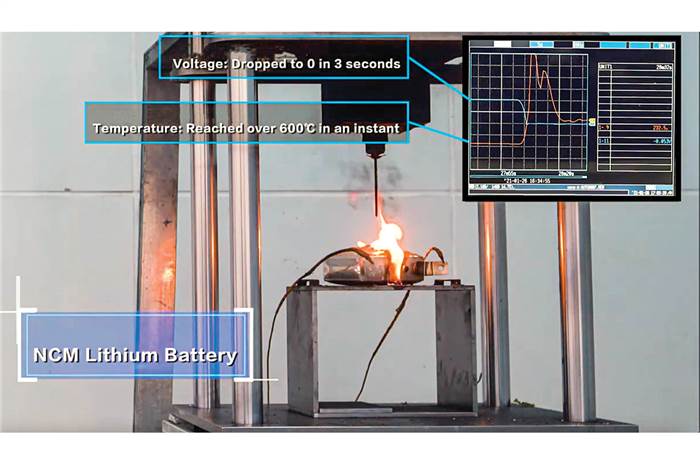 The revered Everest Test. They even place eggs to detect the surface temperature!
The revered Everest Test. They even place eggs to detect the surface temperature!
Blade Battery promises to offer unmatched safety performance, along with a long service life and range, suggests BYD. It utilises LFP technology with 50 percent improvement in volumetric cell density. Not just density, the Blade Battery also passed the most demanding battery test in the EV industry, known as the Nail Penetration or Everest test. In layman’s terms, when a short-circuit is simulated, the Blade Battery neither emits smoke nor catches fire, and its surface temperature reaches a maximum of just 60deg Celsius.
Under the same conditions, a regular lithium-ion battery exceeds 500deg Celsius, making it burn violently. The cars powered by Blade Battery are thus expected to be a lot safer and less susceptible to catastrophic events, even when the batteries are severely damaged. The Blade Battery also passed other extreme tests when it was burnt, crushed, bent, heated in a 300deg Celsius furnace or even overcharged by 260 percent. None of these resulted in a fire or explosion.
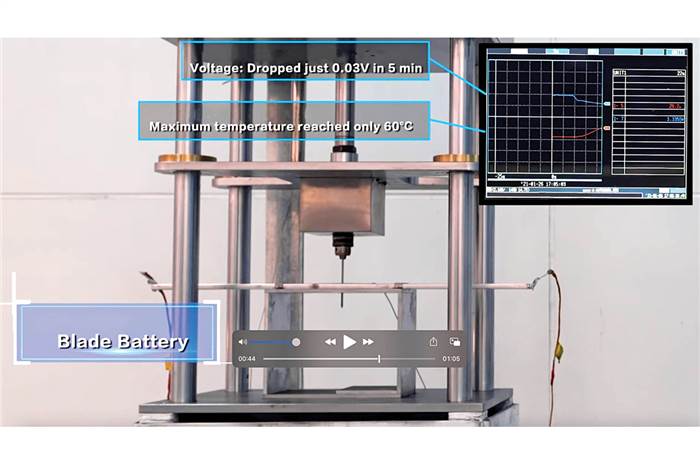 Reaching a max temperature of 60-degree celsius during short-circuit simulation, the battery neither emits smoke nor catches fire.
Reaching a max temperature of 60-degree celsius during short-circuit simulation, the battery neither emits smoke nor catches fire.
The Blade Battery was also thrown under a truck, literally! With a 46-ton, fully-loaded truck being driven over a Blade Battery pack, there was no leakage or deformation. There was no smoke coming out of the battery pack even. BYD was also happy to report that the Blade Battery pack does not release oxygen during breakdowns.
Unlike other manufacturers, running the monotonous race of ‘more range = better car’, BYD has focused on safety as the paramount factor while developing batteries. When range is the primary medium of development, manufacturers tend to focus on ‘energy density’, thus compromising on safety. BYD’s Blade Battery aims to bring safety to the forefront, how it should be.
Under the skin
 EVs powered by the e-Platform 3.0 would be able to hit 100kph in just 2.9 seconds.
EVs powered by the e-Platform 3.0 would be able to hit 100kph in just 2.9 seconds.
On its mission to capture the imagination of the European consumers, while also marking its debut as a passenger carmaker in India, BYD has not just one (read Blade Battery) but multiple trump cards in the bag. To package the future-ready Blade Battery, BYD has developed a highly integrated architecture, christened e-Platform 3.0, which aims to blend in safety, efficiency and style in a single package. Having made its debut in 2021 with the Ocean-X concept, the e-Platform 3.0 promises to be ‘the cradle for the next generation of EVs’, suggests BYD.
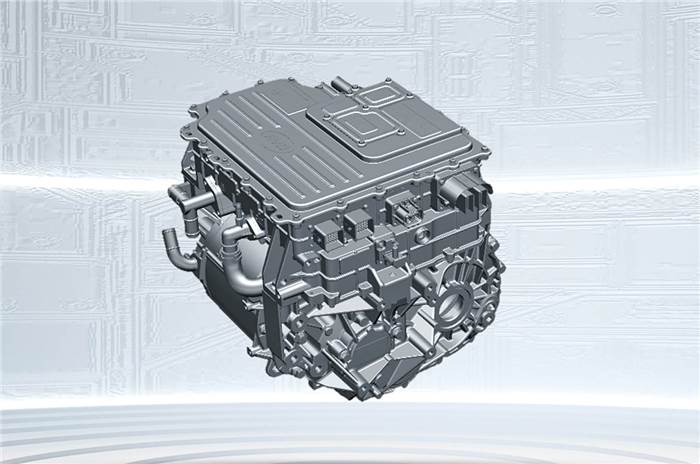 The 8-in-1 High-Efficiency Electric Powertrain is capable of integrating everything, from the motor to the BMS.
The 8-in-1 High-Efficiency Electric Powertrain is capable of integrating everything, from the motor to the BMS.
The e-Platform 3.0 features what BYD claims as the world’s first 8-in-1 High-Efficiency Electric Powertrain integrating the motor, motor controller, reducer, on-board charger, DC converter, HV distribution box, vehicle controller and BMS. This not only helps in reducing the size of the system by 20 percent, but also keeps the weight in check with a drop of 15 percent. The overall efficiency is also a class-leading 89 percent. All the EVs powered by the e-Platform 3.0 benefit from having shorter overhangs and longer wheelbases to infuse more passenger space, while also reducing the ride height. This helps in the reduction of drag to 0.21Cd or even lower, allowing the EV to cut through air fairly easily.
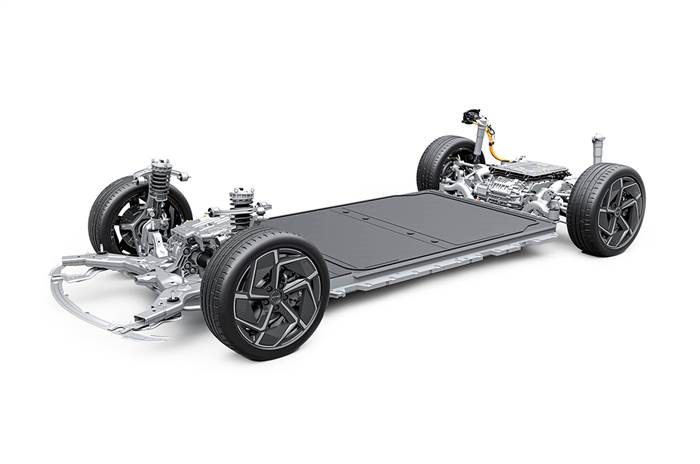 The AWD system on the e-Platform 3.0 is as efficient as a 2WD, claims BYD.
The AWD system on the e-Platform 3.0 is as efficient as a 2WD, claims BYD.
Range you ask? Well, the tight packaging and aerodynamic efficiency takes you to distances beyond 1,000km! BYD has also enabled world-class fast-charging tech, allowing for a range of up to 150km in just 5 minutes. There’s also an all-new AWD system in place for mental acceleration, which would propel the EVs to 100kph in just 2.9sec, claims BYD. The AWD system is efficient too, limiting the energy consumption that is comparable to 2WD cars, without compromising on the high-performance abilities of an AWD.
To help the high-performance Blade Battery breathe better, the direct cooling and heating systems increase the thermal efficiency by 20 percent, reducing energy loss at the same time. The heat pump can work at temperatures ranging from -30deg Celsius to 60deg Celsius, allowing for higher range (up by 20 percent) during winters.
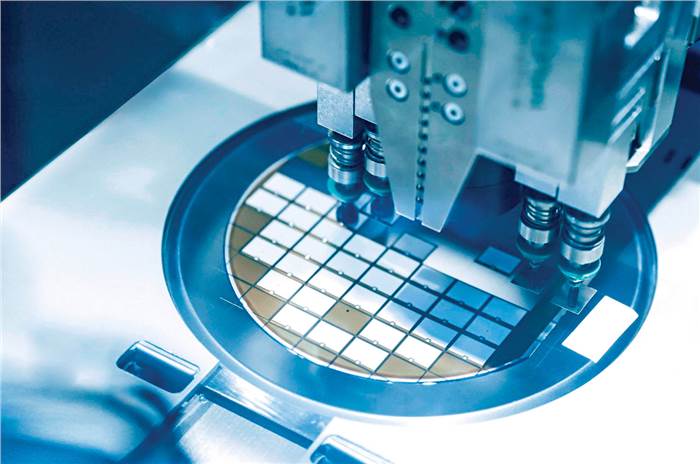 BYD’s in-house facility is capable of producing semiconductors on its own.
BYD’s in-house facility is capable of producing semiconductors on its own.
The EV-specific platform is built on a rugged frame for maximum safety and also comes with intelligent features under the skin. BYD has developed its OS, decoupling hardware and software, offering an entire gamut of collaboration systems for intelligent driving capabilities.
It neatly shares vital information between the drive, brakes and steering system to allow for maximum control. There’s also the smart cockpit domain controller and smart body domain controller in mass production for the future-ready range of EVs. The industry-first domain controller has been developed through the utilisation of the motors’ fast response, all of which will be demonstrated in its upcoming launch.
Also see:
BYD Atto3 EV SUV bookings open; gets 521km range
Copyright (c) Autocar India. All rights reserved.








.png&w=234&h=156&q=90&c=1)

.jpg&w=234&h=156&q=90&c=1)



Comments
Member Login
Personal Details
No comments yet. Be the first to comment.